Special Event, L'Anse aux Meadows, NHSC
L'Anse aux Meadows National Historic Site, NF, July 2017
Once again Ragnarr has hit the high seas in his knarr, taking with him a diverse and eclectic group of craftspeople and their families looking to spend a season or two doing itinerant work around the Viking world before choosing homes. The visit to Iceland went well, but the trip to Greenland was a little rough with a storm blowing them far off course. Ragnar's keen navigation skills brought the boat quickly to Leifsbuðir in Vinland. Good luck prevails (as it usually does for him) and the houses were occupied and not by Freydis. The craftsmen settled in for a short time to trade their skills while waiting for the currents to shift so they could continue their trip to Greenland.
In 2017, DARC returned to L'Anse aux Meadows at the request of Parks Canada to help celebrate Canada's 150th birthday and the 20th year of the interpretive program at L'Anse aux Meadows.
The presentation included hundreds of detailed replicas of period objects:
domestic goods, cooking equipment, simple textile tools, woodworking tools,
basic blacksmithing equipment, weapons, storage, and more. 12 members of DARC spent 10 days demonstrating
a number of activities at various stations in conjunction with the Parks Canada staff.
This visit was featured in this video from the CanadaC3 boat tour.
On most days the first station a visitor encountered was the domestic activities. When weather allowed
this was set up around an open air fire just inside the gate, otherwise it moved into the small dwelling house.
Around this fire Æsa and Auðr made our daily lunches: soups, breads, cheeses. Dishes and laundry
were washed as well.
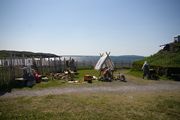 |
 |
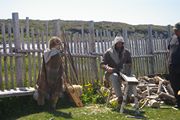 |
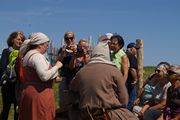 |
| Entrance Overview |
Lunch Dishes |
Draw knife |
Talking to crowd |
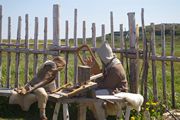 |
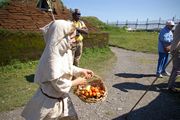 |
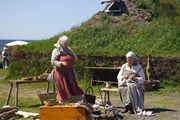 |
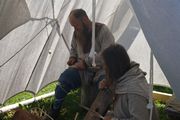 |
| Musical Interlude |
Food Delivery |
Cooking lunch |
Quiet Moment |
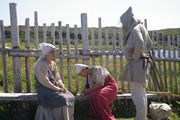 |
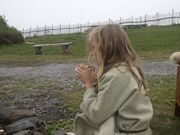 |
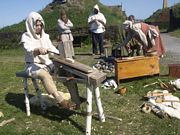 |
 |
| Practicing Runes |
Firestarting |
Enjoying the day |
Frying fish |
Continuing on to the woodworking station Þorgeir could be seen turning bowls on the spring
pole lathe. For most of the visit, he was sheltered from the weather under a canvas awning ( which
required considerable maintenance owing to the blustery winds). However, on rainy days, he abandoned the lathe for shelter in the
main house. Despite the drying winds and occasionally rain, he completed three 7 - 8" diameter bowls during the visit. This is
much lower than the one per day he might hope for, but expected when turning is combined with describing his trade to visitors. Auðr was often seen here working on her netting projects.
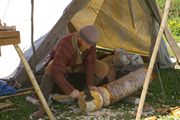 |
 |
 |
 |
| Preparing wood |
Visitors |
Turning bowl |
Adding Runes |
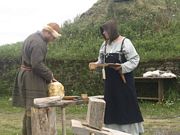 |
 |
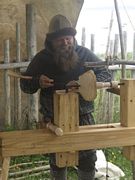 |
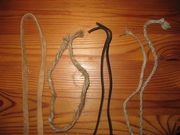 |
| Finished blank |
Preparing the lathe |
Turning! |
Different cords |
 |
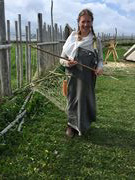 |
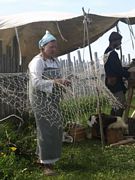 |
|
| Turning waste |
Dip net |
Auðr's large net |
From here a visitor normally proceeded into the main hall to meet with staff from Parks Canada telling stories of Leif's arrival and the building of the hall. The next stop for many visitors was Gudrun's loom and a discussion of the types of weaving, the effort
required to prepare fleece and spin it to prepare to weave. Proceeding further in a visitor could find Kaðlín and Katla for a discussion of spinning, and
naalbinding and a chance to try each of those skills. Tablet weaving was a specialty of Hrobjartr.
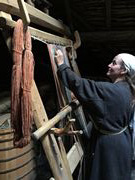 |
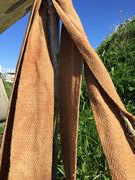 |
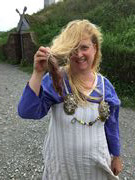 |
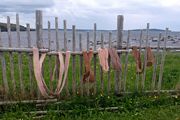 |
| Jorunn Weaving |
Dyed wraps |
Dyeing more |
Dyed items |
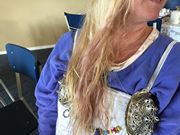 |
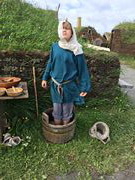 |
 |
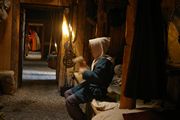 |
| Hair Dyed |
Felting |
Several days work |
Combing |
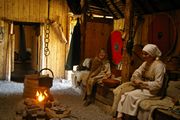 |
 |
 |
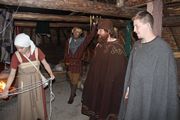 |
| Combing |
Warping the loom |
Weaving and Warping |
Trying to work |
 |
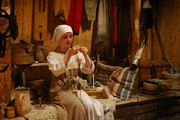 |
 |
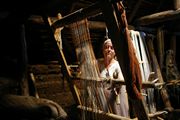 |
| Spinning |
Spinning |
Enjoying the sun |
Weaving |
 |
| | |
| Winding off |
Between the houses the public might come across Ragnarr's trading tent and bead craftwork. Tales of far away places and the exotic materials collected for sale to discerning customers strove to part them from their silver. On display were Iron; worked iron in the form of hinges, arrrow heads; beads, necklaces; fabrics; and more. A visitor could also
engage in a game of hnefatafl, or discuss navigation techniques. In the past Parks Canada has focused on only presenting actives that are known to, or can reasonably be extrapolated to have occurred at the site within the reconstructed area. In past years activities that did not occur on-site were presented outside the enclosure, or at the Visitor Centre. At their request, an active, hands-on, bead making reconstruction was set up. Many of the staff, and some visitors spent time learning the frustrations of bead making in an environment where wind is a constant and highly variable addition to the process. Robert Schweitzer and Parks Canada staff member Arnora added additional staff to this station as required, assisted by many other people as the need arose for another pair of hands on the bellows. On heavier weather days the setup was moved inside.
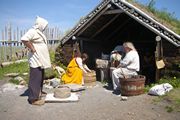 |
 |
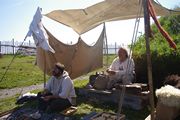 |
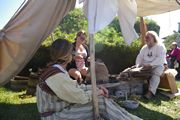 |
| Building Furnaces |
Remember to eat |
Breakfast |
Bead making |
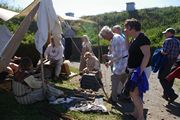 |
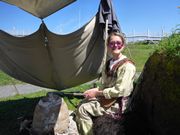 |
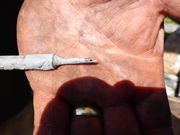 |
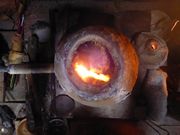 |
| Big Picture |
Bead making |
Broken mandrel |
Burn pattern |
 |
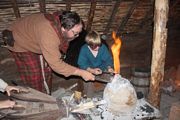 |
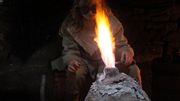 |
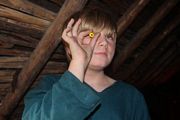 |
| Inside Setup |
Bead making |
Beadmaking focus |
Keiran's Bead |
Outside in the back a visitor might find Ketill and Littli-Ragnarr working on smelting or smithing.
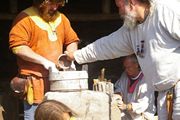 |
 |
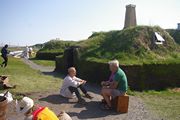 |
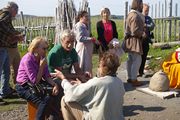 |
| Building smelter |
Watching construction |
Social time |
Discussing the build |
 |
 |
 |
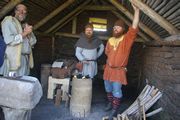 |
| Finishing inside |
Cutting doors |
Setting tuyere |
Drying smelter |
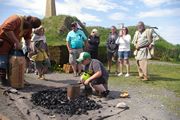 |
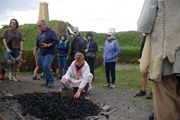 |
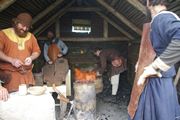 |
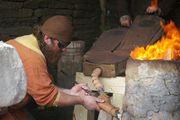 |
| Breaking charcoal |
Breaking charcoal |
Working smelt |
Ragnarr rogering |
 |
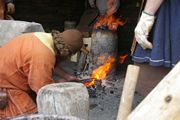 |
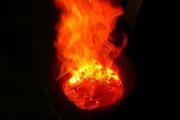 |
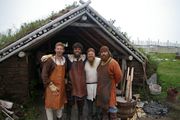 |
| Breaking charcoal |
Tapping smelter |
Fire pretty |
A long day |
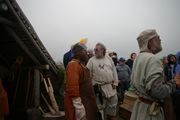 |
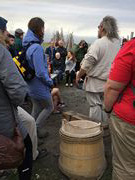 |
 |
 |
| About to extract |
Crowd |
Smelt briefing |
Compacting bloom |
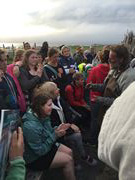 |
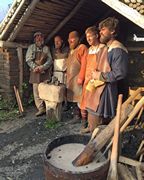 |
 |
 |
| Discussing results |
Team & bloom |
Discussing results |
Smelters' selfie |
 |
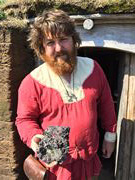 |
 |
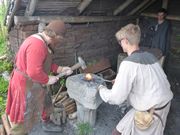 |
| Bloom conversation |
Littli-Ragnarr & bloom |
Pulling fragment |
Consolodating fragment |
Some additional unplanned activities occurred.
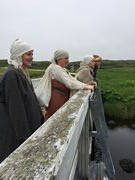 |
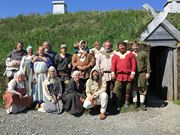 |
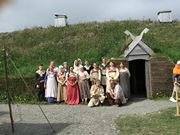 |
 |
| Bridge view |
Group Photo |
Group Photo |
High Winds |
 |
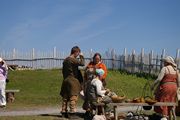 |
 |
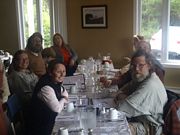 |
| Restful evening |
Social time |
Social time |
Dinners |
 |
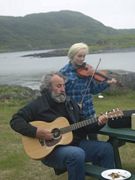 |
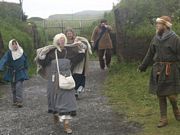 |
|
| Steak & Pizza night |
Entertainment |
Day's end |
In addition to the experiential nature of the presentations there is always a chance to try adding an experiment or two, or collecting some data in this environment.
The first of these was the oven mitt. The bead furnace seen above has a white line near the top. The furnace above that line lifts off allowing the furnace to be refilled with charcoal. The top is then replaced and sealed with a simple wet clay mix that is painted over the seal. For years we have simply used a modern welders glove for protection when lifting the (very hot) lid. One question that has always been outstanding was 'what might they have used'. On this trip we decided to test a theory we had. Kaðlín used nalbinding to create a mitten like those found in sites such as Iceland using Icelandic wool. It was originally thought that due to the high level of heat (the gases exiting the chimney can be in excess of 1200°C) a complex design such as two mittens with a leather insert might be required. The design tested over the course of several days involved only stuffing one side of the mitten with the remains from the wool being combed for spinning. This proved entirely acceptable for the periods of contact required. The mitten itself received only minor damage over those days. This will be followed up with some additional observations including temperature readings of the external face of the chimney and a time/temperature curve for inside the mitten. A count of usage and damage will also be recorded over time. These results will be published in the future.
This experience also allowed us to partially answer a question we have had for a while on the long-term durability of a bead furnace. This furnace was built, very poorly cured (only dried for about 16 hours before firing), and then fired and used. It was then used for around 5 hours every day for 8 days. While the oven was moved between the longhouse and outdoors for the last five days (for fear of burning the longhouse - as a sidenote, the downward heat of the furnace is sufficient to char through an inch thick plank of wood), it received minimal vibrations from that motion which would cause it to break down. At the end of day eight it was still functional but the cob was much more fragile, and particular care was required when removing and replacing the lid.
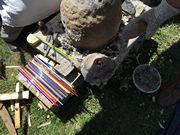 |
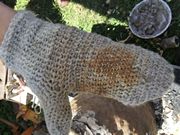 |
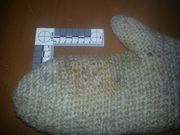 |
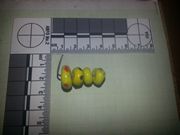 |
| Replacing top |
Hot mitten |
One week of use |
Ragnarr's beads |
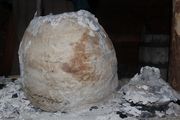 |
| | |
| Furnace after 8 days |
The second was a question of audio. During each visit to L'Anse aux Meadows music forms a minor part of the presentation. The question of how the instruments sounds might be impacted by the acoustic qualities of the hall had always interested Rig. This year recordings were made of Rig's lyre and Parks Canada Staff member Wade Hillier's lyre being played both outside and inside the reconstructed hall from a variety of distances in different rooms. These audio files will be compared over the next while to determine the impact of the sod houses on the acoustics.
Finally, while turning on the lathe, Þorgeir experimented with the use of a variety of drive cords. In order to spin the work piece, a mandrel is driven into what will be the centre of the inside of the bowl and a cord or thong connecting the foot pedal to the spring pole is wrapped around the mandrel such that when the pedal is depressed, the mandel (and work piece) revolve. Until recently, Þorgeir had focused on the use of scrap ~1/8 - 3/16” square leather lacing. However, not all thongs and leather are created equal and he had been having trouble finding a supply of lacing that was sufficiently hard wearing. Because the lathe was set to be left at the site after the visit and the last of Þorgeir's workable lacing was nearly exhausted, several alternative materials were tested during the visit, including purchased 1/8” latigo lacing, single ply natural jute twine, and 4-strand hemp cord made on-site by Bonnie and Jo using a slung (Danish whipcording) technique. Both the latigo lacing and the jute twine failed quickly and did not represent viable materials. However, the whipcord worked excellently, a single strand generally lasting through a couple of days of continual and often hard use. Measurements before after use indicated that the cord stretched only 7% during use, although this was probably localised to the region that ran on the mandrel. Although alternative even more durable materials are being sought (suggestions included seal or walrus hide), the capacity for the whipcord to be replaced easily using on-site materials and in-period production methods makes it a highly viable interim solution.
Data for the smelt was collected in the usual way and will be added to our growing list of smelt experimental data. Of particular interest in this setting is the 'charge time'. This is time needed to burn 2 Kg of charcoal. Human powered air (via a bellows) generally has a larger charge time than blower powered air. At this point we are building up a respectable number of human powered experiments enabling us to compare the range and variance of the charge time.
 Dark Ages Re-Creation Company
Dark Ages Re-Creation Company



















































